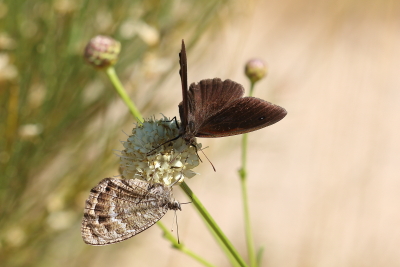
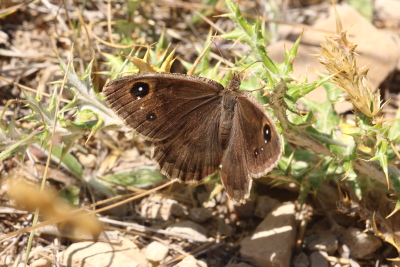
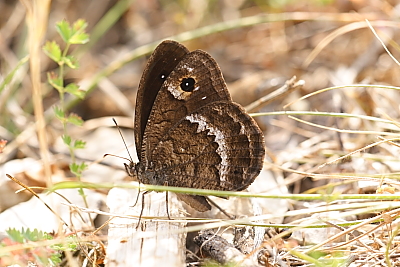
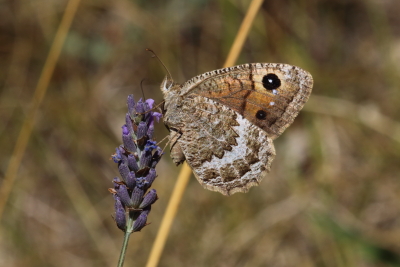
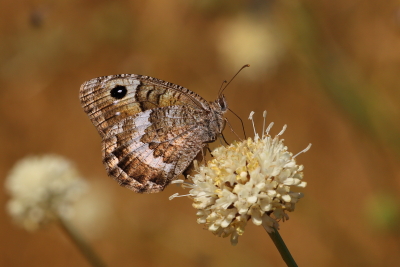
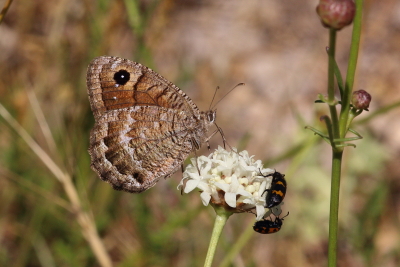
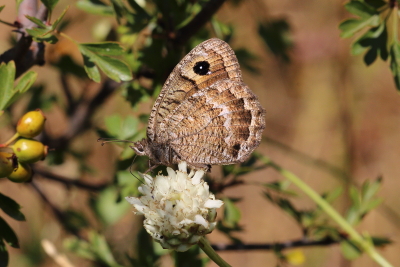
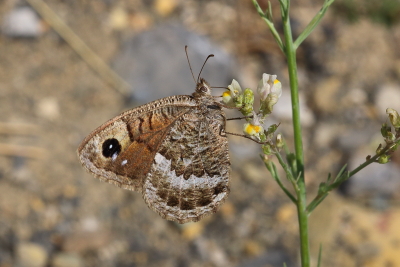
Black Satyr (Satyrus actaea)
2024 photographs highlighted in yellow. Click on any photograph to go to an enlarged picture, or simply scroll down the page.
|
Actaea is not particularly common and I have rarely seen it in good numbers. It is a butterfly of medium altitudes, usually found from 500 to 1200m, although Lafranchis gives the altitude range as 0-1600m.
Actaea is essentially an Iberian species with a distribution extending eastwards, reaching Var and the Alpes-Maritimes, whereas the closely-related Great Sooty Satyr (S. ferula) has a distribution principally in the Balkan region but extending westwards through the southern Alpes and the upland areas of southern France and into the Pyrénées.
It is quite similar to ferula which is much more common, the problems of identification being made more difficult by the variability of ferula, but ferula has two ocelli on the forewing (on both the upperside and underside) while actaea has only one (but see the notes on 46485 below), and ferula is generally larger. The ocelli identification clue is not particularly helpful in the field because neither settle very often with open wings, and usually the forewing is lowered when the wings are closed, making it impossible to see whether a second ocellus exists. The unh of both ferula and actaea are only slightly different, with male actaea having a more jagged discal line and a distinctive white submarginal band. |
However, the discal line of ferula can be quite
serrated and still be within the range for ferula. The jaggedness of the
line has to be really quite accentuated to be in the frame for actaea.
Additionally, ferula can be quite black in ground colour, so this is not
a reliable indication. The only really sure way to tell is by seeing the
forewing ocelli on either the upperside or underside. I have concluded that the flight period, being late July and August, is the principal reason why I have not seen more actaea as I am not usually in Var at that time. However, in 2017 I made travel plans to ensure that I was at two known sites in mid-July. Even that might have been a little late, as females were preponderant at the time I was there, hence the selection of photographs on this page. |
|
ref |
sex |
observations |
alt. m |
| 44368 | M | a male (above) courting the female below. It appears that there may be a second lower ocellus (which would indicate ferula rather than actaea) on the forewing, as there is a small white mark. On an expanded view, it is clear that this is just a reflection on a vein, maybe where it catches the sun. In any event, a second ocellus would in the space between the veins, not on a vein. Additionally, it is courting what is clearly a female actaea. | 680 |
| 46485 | F |
well, is this actaea? It matches actaea perfectly for size (smaller than
ferula), has the rounded wing shape expected for actaea, unf markings and the
unh jagged line (46489 is the underside), all very strong indicators of actaea.
And the margins are brown, whereas for ferula they are white or at least much
lighter. Against that, and it is a strong against, there is a second ocellus in
s2. However, this second ocellus is much smaller than the main one in s5. And
the upperside is much different to what I would expect for ferula (contrast with
17009 on the ferula page). I also had doubts about the upf white spots
which I would normally assume to be an indicator of ferula, although on
checking T&L, it says that white spots
here are often the case. I checked Google for images of actaea and there
were several pinned specimens from apparently reliable sources that had a second
ocellus in s2. It appears that there are very few images of female uppersides on
the web, actaea being a species that usually rests with wings closed. On balance I think it is actaea, which would mean that (female) actaea can have a small ocellus in s2. I have found no evidence that the male can have a second ocellus in s2, so it would appear that - if a second ocellus is possible - it only occurs in the female. The ocelli of Erebia species are notoriously variable, and T&L says that the markings of actaea can be very variable, without specifically mentioning a second ocellus. And it was in a location I have visited many times and have seen actaea in good numbers, and have never seen ferula there. Comment invited. |
680 |
|
33836 |
M |
a clear example of actaea, strong jagged discal line with a white post-discal band, and very dark indicating why this species has black in its name. |
680 |
| 46489 | F | the underside of 46485. | 680 |
| 44254 | F | a female. All of the females on this page are very similar, indicating that there is relatively little variation in the female underside - contrast with the female ferula underside, which is really quite variable. | 640 |
| 44286 | F | another female underside, from the same location as 44254. | 680 |
| 44291 | F | another female underside, from the same location as 44254. | 680 |
| 44632 | F | another female underside, but this time from the same location as 44254. | 1000 |
44254_female_Bouches-du-Rhône_16Jul17
44632_female_Alpes-Maritimes_19Jul17